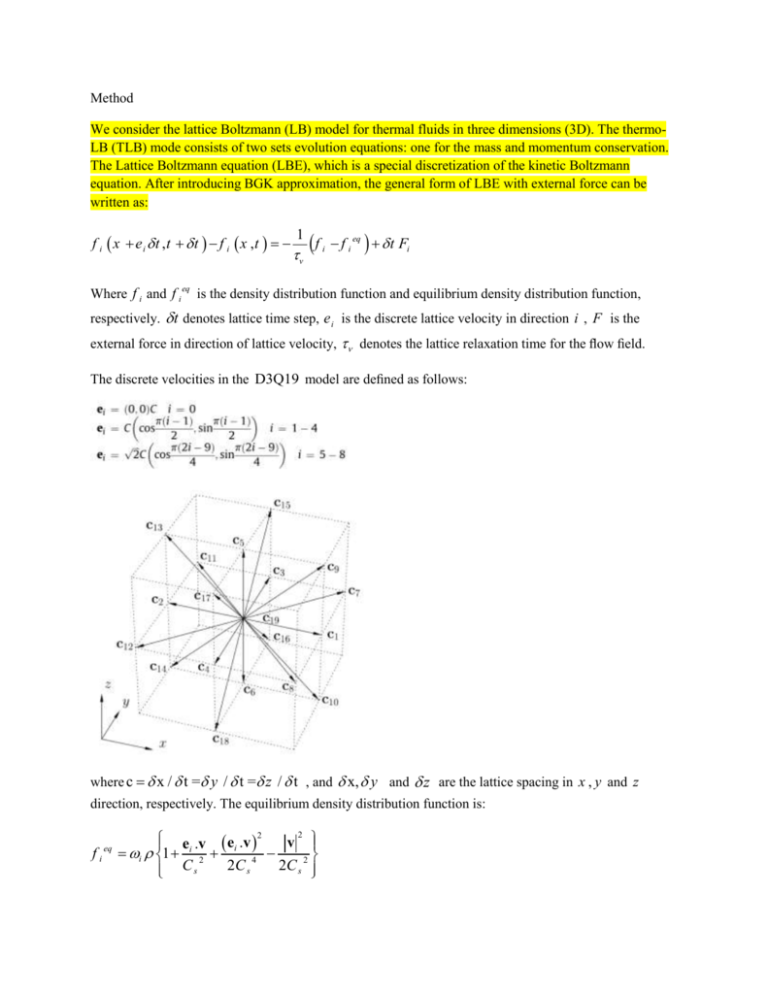Method We consider the lattice Boltzmann (LB) model for thermal
advertisement

Method We consider the lattice Boltzmann (LB) model for thermal fluids in three dimensions (3D). The thermoLB (TLB) mode consists of two sets evolution equations: one for the mass and momentum conservation. The Lattice Boltzmann equation (LBE), which is a special discretization of the kinetic Boltzmann equation. After introducing BGK approximation, the general form of LBE with external force can be written as: f i x e i t ,t t f i x ,t 1 v f i f i eq t Fi Where f i and f i eq is the density distribution function and equilibrium density distribution function, respectively. t denotes lattice time step, e i is the discrete lattice velocity in direction i , F is the external force in direction of lattice velocity, denotes the lattice relaxation time for the flow field. The discrete velocities in the D3Q19 model are defined as follows: where c x / t = y / t = z / t , and x, y and z are the lattice spacing in x , y and z direction, respectively. The equilibrium density distribution function is: fi eq 2 e .v ei .v 2 v i i 1 2 2C s 4 2C s 2 C s Where the weighting factors i ,…….(weight factors should be written) , v velocity, density and C s is speed of sound in Lattice scale and given by: C 3 Cs The corresponding kinematic viscosity is given by: v v 0.5C s2 t In order to incorporate buoyancy force in the model, the force term in the Eq. (1) need to be calculated as below in vertical direction (y): Fi i F .e i / c s2 Where F g T and T T h T c is macroscopic temperature difference between hot and cold walls. Finally, macroscopic variable can be calculated in terms of these variables, with the following formula: m i f i i u 1 i m i f i ei The temperature is modeled by the following energy equation: vx 2T 2T 2T T T T v y v z nf 2 2 2 x y z y z x Where v x ,v y and v z are velocities in x , y and z directions, respectively. np is nanofluid thermal diffusivity. In order to simulate the nanofluid by the LBM, because of the interparticle potentials and other forces on the nanoparticles, the nanofluid behaves differently from the pure liquid from the mesoscopic point of view and is of higher efficiency in energy transport as well as better stabilization than the common solid-liquid mixture. For pure fluid in absence of nanoparticles in the enclosures, the governing equations are Eqs. (1)e(6). However for modeling the nanofluid because of changing in the fluid thermal conductivity, density, heat capacitance and thermal expansion, some of the governed equations should be changed. The thermal diffusivity is written as: nf k nf c p nf The effect of density at reference temperature is given by: nf 1 f p And the heat capacitance and thermal expansion of nanofluid can be given as [26] c p nf nf 1 c p c p f p 1 bf p The viscosity of the nanofluid containing a dilute suspension of small rigid spherical-particles is given by Brinkman model [20] as: nf f 2.5 1 The effective thermal conductivity of the two component entities of spherical-particle suspension was introduced by Chon et al. [37] as follow: k p 2k f 2 k f k p k nf kf k p 2k f k f k p The dimensionless relaxation time for velocity field which is determined by the nanofluid properties as follow: Boundary Condition The distribution functions out of the domain are known from the streaming process. The unknown distribution functions are those toward the domain. Fig. 1 shows the unknown distribution function, which are needed to be determined, as dotted lines. For flow Bounce back boundary condition is used on the solid boundaries For temeperature شرايط مرزي عبارتند از: 𝑥 = 0, 0 ≤ 𝑦 ≤ 𝐿 , 0 ≤ 𝑧 ≤ 𝐿: 𝑇 = 𝑇ℎ , 𝑣𝑥 = 𝑣𝑦 = 𝑣𝑧 = 0 𝑥 = 𝐿, 0 ≤ 𝑦 ≤ 𝐿 , 0 ≤ 𝑧 ≤ 𝐿: 𝑇 = 𝑇𝑙 , 𝑣𝑥 = 𝑣𝑦 = 𝑣𝑧 = 0 = 0, 𝑣𝑥 = 𝑣𝑦 = 𝑣𝑧 = 0 𝑇𝜕 𝑦𝜕 𝑦 = 0, 0 ≤ 𝑥 ≤ 𝐿 , 0 ≤ 𝑧 ≤ 𝐿: = 0, 𝑣𝑥 = 𝑣𝑦 = 𝑣𝑧 = 0 𝑇𝜕 𝑦𝜕 𝑦 = 𝐿, 0 ≤ 𝑥 ≤ 𝐿 , 0 ≤ 𝑧 ≤ 𝐿: = 0, 𝑣𝑥 = 𝑣𝑦 = 𝑣𝑧 = 0 𝑇𝜕 𝑧𝜕 𝑧 = 0, 0 ≤ 𝑥 ≤ 𝐿 , 0 ≤ 𝑦 ≤ 𝐿: = 0, 𝑣𝑥 = 𝑣𝑦 = 𝑣𝑧 = 0 𝑇𝜕 𝑧𝜕 𝑧 = 𝐿, 0 ≤ 𝑥 ≤ 𝐿 , 0 ≤ 𝑦 ≤ 𝐿: قانون برخورد-بازگشت براي شرايط مرزي عدم لغزش در ديووار هاي جامذ به کار گرفته شد است .به عنوان مثال تابع توزيع چگالي در مرزسمت چپ بايد در معادلهي زير صدق کند: )𝑦 𝑓1 (𝑥, 𝑦) = 𝑓̃3 (𝑥, )𝑦 𝑓5 (𝑥, 𝑦) = 𝑓̃7 (𝑥, )𝑦 𝑓8 (𝑥, 𝑦) = 𝑓̃6 (𝑥, 𝐻ℎ 𝑓𝑘 = 𝑢𝑁 𝑤𝑞 𝐿𝑇 𝑇𝐻 − =ℎ 𝑤𝑞 𝑥𝜕𝜕𝑇⁄ 𝑘𝑛𝑓 = − 𝑇𝜕 𝑓𝑛𝑘 ) 𝑥𝜕 𝑓𝑘 ( 𝑁𝑢 = − 1 𝑓𝑛𝑘 )𝑧 𝜕𝑇(𝑦, 𝑧𝑑 ∫) | 𝑘𝑓 0 𝑥𝜕 𝑥 = 0 𝑜𝑟 𝑥 = 1 ( 𝑁𝑢𝑎𝑣𝑔 (𝑦) = − 1 𝑁𝑢𝑜𝑣𝑒𝑟𝑎𝑙𝑙 = ∫ 𝑁𝑢𝑎𝑣𝑔 (𝑦)𝑑𝑦 0 𝑃𝑟 = 𝑣 ⁄𝛼 𝑅𝑎 = (𝑔𝛽∆𝑇𝐿3 )⁄(𝑣𝛼) ∆𝑇 = 𝑇ℎ − 𝑇𝑙 [26]Y. Xuan, W. Roetzel, Conceptions for heat transfer correlation of nanofluids,Int. J. Heat Mass Transf. 43 (2000) 3701e3707. [20] E. Abu-Nada, Z. Masoud, A. Hijazi, Natural convection heat transfer enhancement in horizontal concentric annuli using nanofluids, Int. Commun. Heat Mass 35 (5) (2008) 657e665.











